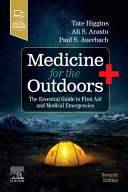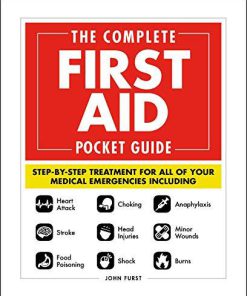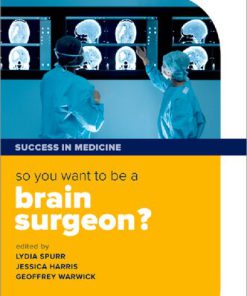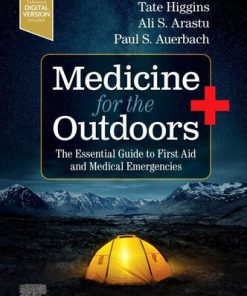Medicine for the Outdoors The Essential Guide to First Aid and Medical Emergencies 7th Edition by Tate Higgins, Ali S Arastu, Paul S Auerbach ISBN 9780323680561 0323680569
$50.00 Original price was: $50.00.$25.00Current price is: $25.00.
Medicine for the Outdoors The Essential Guide to First Aid and Medical Emergencies 7th Edition by Tate Higgins, Ali S Arastu, Paul S Auerbach – Ebook PDF Instant Download/Delivery: 9780323680561 ,0323680569
Full download Medicine for the Outdoors The Essential Guide to First Aid and Medical Emergencies 7th Edition after payment

Product details:
ISBN 10: 0323680569
ISBN 13: 9780323680561
Author: Tate Higgins, Ali S Arastu, Paul S Auerbach
For nearly 40 years, Medicine for the Outdoors: The Essential Guide to First Aid and Medical Emergencies has been the take-along manual of choice for anyone venturing into the mountains, forest, desert, or on water. This essential guide provides highly illustrated, easy-to-follow guidance on immediate stabilization and treatment of persons with virtually any possible medical problem—designed for on-the-spot use when higher-level medical care is not accessible. Written by experts in outdoor medicine, this updated edition helps you manage any situation until medical personnel can take over.
-
Covers key information on a wide range of disorders related to specific environments, including natural disasters, high-altitude problems, water-related incidents, heat- and cold-related illnesses, and wildland fires.
-
Provides easy-to-understand recommendations for dealing with animal attacks, venomous wildlife, wild plant and mushroom poisoning, minor and major medical problems, infectious diseases, water disinfection, and severe bleeding.
-
Discusses key topics, including antibiotics, medicines, opioid overdose treatment, wound closure techniques, severe bleeding, spinal assessment and immobilization, tourniquets, the use of a Gamow bag for severe altitude illness, splinting, dental emergencies, disaster preparedness, global conflict guidelines, canine medicine, today’s infectious disease threats, and much more.
-
Includes up-to-date guidelines, even more helpful illustrations and diagrams, and a new chapter: Patient Assessment: A Structured Approach to Emergencies in the Outdoors.
-
Includes advanced topics valuable to physicians and expedition medical staff at all levels of training and experience.
Medicine for the Outdoors The Essential Guide to First Aid and Medical Emergencies 7th Edition Table of contents:
Part One. General Information
How to use this book
Before you go
Be in good health
Be prepared
Common sense
Falls prevention
Rules of the road
Conditioning and acclimatization
Equipment
Trip plans
Medicines
Nutrition
Fluid requirements
Personal hygiene and bodily waste disposal
General injury prevention: Risk factors
Disaster preparedness
Disaster response triage
Duty to assist
General first aid principles
While you are waiting for help to arrive
Assisting a victim of starvation
Medical decision-making
Hand offs
Patient assessment–a structured approach to emergencies in the outdoors
Overview
Primary survey (a search for immediate life threats)
A note on ABC vs. CAB
Airway
Choking
Helmet removal
Breathing
How to assist breathing (mouth-to-mouth)
Circulation
Disability and neurologic status
Logrolling the victim (see Figs. 27 and 28)
Lifting and moving a victim
Expose and environment
The secondary survey
The physical exam
Vital signs by age group
Pulse oximetry
Temperature
History
Part Two. Major Medical Problems
Introduction
An approach to the unconscious victim
Drug overdose
Long-term care of an unconscious or gravely disabled person
Chest injury
Broken ribs
Flail chest
Pneumothorax
Bruised lung
Treatment for chest injuries
Serious lung disorders
Asthma
Pulmonary embolism
Heart failure (often called “congestive heart failure”)
Chronic obstructive pulmonary disease
Pneumonia
Chest pain
Angina pectoris
Heart attack (acute myocardial infarction “AMI” or “MI”)
Treatment for a suspected heart attack
Aortic dissection
Very rapid heart rate
High blood pressure
Noncardiac causes of chest pain
Bleeding
Treatment for bleeding
Applying a tourniquet
Internal bleeding
Shock
Head injury
Concussion
Treatment principles for head injuries
Simplified motor score
AVPU
ACDU
Pain control
Lacerations of the scalp
Allergic reaction
Treatment for a severe allergic reaction (anaphylaxis)
Seizure
Treatment for seizure
Fractures and dislocations
Compartment syndrome
Splints and slings
Taping
Specific injuries
Neck
Logrolling the victim (see Figs. 27 and 28)
“Clearing” a cervical spine
Skull and face
Nose
Jaw
Wrist, hand, and finger
Forearm
Elbow
“Nursemaid’s elbow”
Upper arm
Collarbone (clavicle)
Shoulder dislocation
Shoulder separation
Rib
Thoracic and lumbar spine (chest and lower back)
Pelvis
Tailbone (coccyx)
Femur
Hip
Knee and kneecap
Lower leg
Ankle
Toe
Heel
Amputation
Burns
Definitions (Fig. 132)
Treatment for burns
Tar burn
Burn prevention
Inhalation injuries
Thermal injury
Smoke (chemical) injury
Air quality index for particles
Aspiration injury
Carbon monoxide poisoning
Abdominal pain
General evaluation
Physical examination
Epigastrium
Right upper quadrant
Left upper quadrant
Right lower quadrant
Left lower quadrant
Lower abdomen (central)
Flanks (sides of lower back)
Problems of ovaries and vagina
Ovarian infection
Ovulation, ovarian cyst, and torsed (twisted) ovary
Bleeding from the vagina
Vaginitis, vaginal discharge, and vaginal infections
Emergency contraception
Safe sex
Disorders of the kidneys, bladder, and prostate
Bladder infection
Kidney infection
Kidney stone
Blood in the urine
Acute urinary retention
Prostate infection
Problems of the penis and testicles
Painful testicle
Penile discharge
Infection of the foreskin (balanitis)
Safe sex
Emergency childbirth
Complicated deliveries
Cellulitis of the breast (mastitis)
Diabetes
Stroke
Infectious diseases
Fever in the returning traveler
Malaria
Yellow fever
Dengue
Chikungunya fever
West nile viral disease
Zika virus disease
Eastern equine encephalitis
Tick bites and prevention
Relapsing fever
Rocky mountain spotted fever
Colorado tick fever
Lyme disease
Ehrlichiosis
Anaplasmosis
African tick-bite fever
Babesiosis
Schistosomiasis
Trichinellosis (trichinosis)
Leptospirosis
Tularemia
Typhoid and paratyphoid fevers
Meningococcal disease (including meningitis)
Tetanus
Ebola, lassa, and other viruses that cause “hemorrhagic fevers”
Emerging infectious diseases
COVID-19
Rabies
Part Three. Minor Medical Problems
Introduction
General symptoms
Fainting
Fatigue
Fever and chills
Cough
Coughing blood
Hiccups (hiccoughs)
Dizziness
Head (including eye, ear, nose, throat, and mouth)
Headache
Bell’s palsy
Ear and hearing
Eye
Contact lenses
Nose
Throat
Mouth and teeth (dental)
Upper respiratory disorders
Common cold
Influenza
Bronchitis
Pleuritis
Hay fever
Disorders of the gastrointestinal tract
Diarrhea
Gluten sensitivity
Constipation
Hemorrhoids, anal fissure, and rectal prolapse
Flatus
Heartburn
Nausea and vomiting
Vomiting blood
Ulcer disease
Hepatitis
Skin disorders
Sunburn
Sunscreens
Melanoma
Poison ivy, sumac, and oak (genus toxicodendron)
Other irritating plants
Rashes incurred in the water
Hives
Heat rash
Intertrigo
Chafe
Impetigo
Cellulitis, including from methicillin-resistant staphylococcus aureus
Abscess
Ingrown toenail
Fingertip cracks
Paronychia
Felon
Blisters
Plantar warts
Athlete’s foot, ringworm, and jock itch
Tinea versicolor
Onychomycosis
Good foot care
Diaper rash
Armpit odor
Lice
Scabies
Creeping eruption
Shingles
Herpes simplex virus genital infection
Fever blisters
Minor bruises and wounds
Bruises
Black eye
Blood under the fingernail
Torn fingernail
Puncture wounds
Impaled object
Scrapes
Cuts (lacerations)
Skin flaps and avulsions
Taping a wound closed
Sewing (suturing) a wound closed
Stapling a wound closed
Gluing a wound closed
Dress the wound
Wound infection
Seek medical care
Bandaging techniques
Abscess (boil)
Scalp laceration (cut on the head)
Fishhook removal
Splinter removal
Blisters
Musculoskeletal injuries
Overuse syndromes
Carpal tunnel syndrome
Cyclist’s palsy
Saturday night palsy
Rotator cuff tendinitis
Turf toe
Muscle fatigue
Shin splints
Plantar fasciitis
Torn muscle
Sprains, strains, and tendon rupture
Muscle cramps
Arthritis
Bursitis
Venous thrombosis and thrombophlebitis
Back pain
Mental health (psychiatric) emergencies
Anxiety
Panic
Depression
Delirium
Psychosis
Reaction to an injury or illness (acute stress disorder)
Posttraumatic stress disorder
Attention deficit hyperactivity disorder
Part Four. Disorders Related to Specific Environments
Injuries and illnesses due to cold
Hypothermia (lowered body temperature)
Prevention of hypothermia
Mild hypothermia
Moderate hypothermia
Severe and profound hypothermia
Rewarming and preparing a hypothermic victim for transport
Cold water immersion
What to do if you fall through the ice
How to assist someone who has fallen through the ice
Winter storm preparedness
Safe sledding
Frostbite
Treatment of frostbite
Stages of frostbite
Wound management after thawing
Prevention of frostbite
Frostnip
Immersion foot (trench foot)
Chilblain (pernio)
Raynaud’s phenomenon
Hives induced by exposure to cold
Snow blindness
Injuries and illnesses due to heat
Burn injuries
Heat-related illness (hyperthermia)
Heat exhaustion and heat stroke
Cooling the victim
Muscle cramps
Heat swelling
Fainting
Avoiding heat illness
Wildland fires
High-risk situations
Standard fire encounter principles
What to do when caught in a wildland fire
High altitude–related problems
Prevention of high altitude–related disorders
High-altitude pulmonary edema
High-altitude cerebral edema
Acute mountain sickness
Gamow bag (portable hyperbaric chamber)
Other disorders of high altitude
Snakebite
Venomous snakes
Signs of envenomation
Pit vipers
Coral snakes
Treatment of snakebite
Avoidance of venomous snakes
Nonvenomous snakes
Gila monster and Mexican beaded lizard
Insect and arthropod bites
Bees, wasps, hornets, and ants
Spiders
Scorpions
Mosquitoes
Mosquito avoidance
Biting flies
Fleas
Chiggers
Centipedes and millipedes
Ticks
Tick avoidance
Tick removal
Tick bite and red meat allergy
Caterpillars
Beetles
Sucking bugs
Skin infestation by fly larvae
Insect repellents and other protection against insects
Screens, bed nets, coils, candles, shields, and traps
Repellents
Leeches
Lightning strike, tornado (cyclone), hurricane (typhoon), flood, earthquake, tidal wave (tsunami), landslide (mudslide), volcano, and snow avalanche
Lightning strike
Lightning avoidance and how to seek safety
Tornado avoidance and how to seek safety
Hurricane: How to seek safety
Flood: How to seek safety
Earthquake: What to do and how to seek safety
Tidal wave: How to seek safety
Landslide: How to seek safety
Volcano
What to do if working or traveling near an active volcano
Snow avalanche
Hazardous aquatic life and aquatic infections
Sharks
Shark avoidance
Barracudas
Moray eels
Sponges
Jellyfish
Coral and barnacle cuts
Sea urchins
Starfish
Cucumbers
Bristleworms
Cone snails (shells)
Stingrays
Avoidance of stingray injuries
Catfish
Scorpionfish
Surgeonfish
Octopuses
Sea snakes
Skin rashes caused by aquatic plants (seaweed dermatitis) or creatures (sea bather’s eruption, swimmer’s itch)
Poisonings from seafood
Scombroid fish poisoning
Pufferfish poisoning
Ciguatera fish poisoning
Paralytic shellfish poisoning
Hallucinatory fish poisoning
Anisakidosis
Underwater diving accidents
Air embolism
Decompression sickness (the “bends”)
Nitrogen narcosis
Ear squeeze
Sinus squeeze
Tooth squeeze
Drowning
Recognizing a victim of drowning
Prevention of drowning
Animal attacks
Animal attacks
General treatment
Special considerations
Avoidance of hazardous animals
Wild plant and mushroom poisoning
Medical history
Treatment for poisonings
Commonly ingested toxic plants and mushrooms
Toxicity of common plants
Part Five. Miscellaneous Information
Oxygen administration
Precautions
Water disinfection
Motion sickness
Jet lag
In flight
Personal safety in an age of conflict, kidnapping, and terrorism
Safe travel
Kidnapping and hostage behavior
Piracy
Blast injuries
First aid kits
Basic supplies
General supplies to consider
Wound care: Preparations and dressings
Splinting and sling material
Eye medications and dressings
Dental supplies
Topical skin preparations
Nonprescription medications
Prescription medications (select what you feel you might need; the drugs listed are “for example”)
Allergy kit
Forest and mountain environments
Aquatic environments
Physicians abroad
Immunizations
Transport of the injured victim
Lifting and moving techniques
Carries and litters
Helicopters
Ground-to-air distress signals
Lost people
Procedures
Intramuscular injection
Fishhook removal
Splinter removal
Ring removal
Zipper removal
Knots and hitches
Dealing with death
Handling a dead body
Emotional considerations
Obtaining assistance
Appendices
Appendix One: Commonly used drugs (medications) and doses
Appendix Two: Conversion tables
Appendix Three: Guidelines for prevention of diseases transmitted via human blood and other bodily fluids
Appendix Four: Commonly used applications of the SAM splint
Appendix Five: Emergency canine medicine
Glossary (Including Acronyms and Abbreviations)
Index
People also search for Medicine for the Outdoors The Essential Guide to First Aid and Medical Emergencies 7th Edition:
medicine for the outdoors
wilderness medicine guide
basic first aid in the wilderness
essential first aid items for hiking
basic outdoor first aid
Tags: Tate Higgins, Ali S Arastu, Paul S Auerbach, Medicine, First Aid, Medical Emergencies
You may also like…
Uncategorized
Medicine - Others
Jurisprudence & Law - Legal Reference
Nolo s Essential Guide to Buying Your First Home 7th Edition Ilona Bray
Medicine - Clinical Medicine
First Aid for the USMLE Step 1 2022 – A Student-to-Student Guide 2022nd Edition Tao Le
Medicine - Pediatrics
Uncategorized
Medicine - Others











